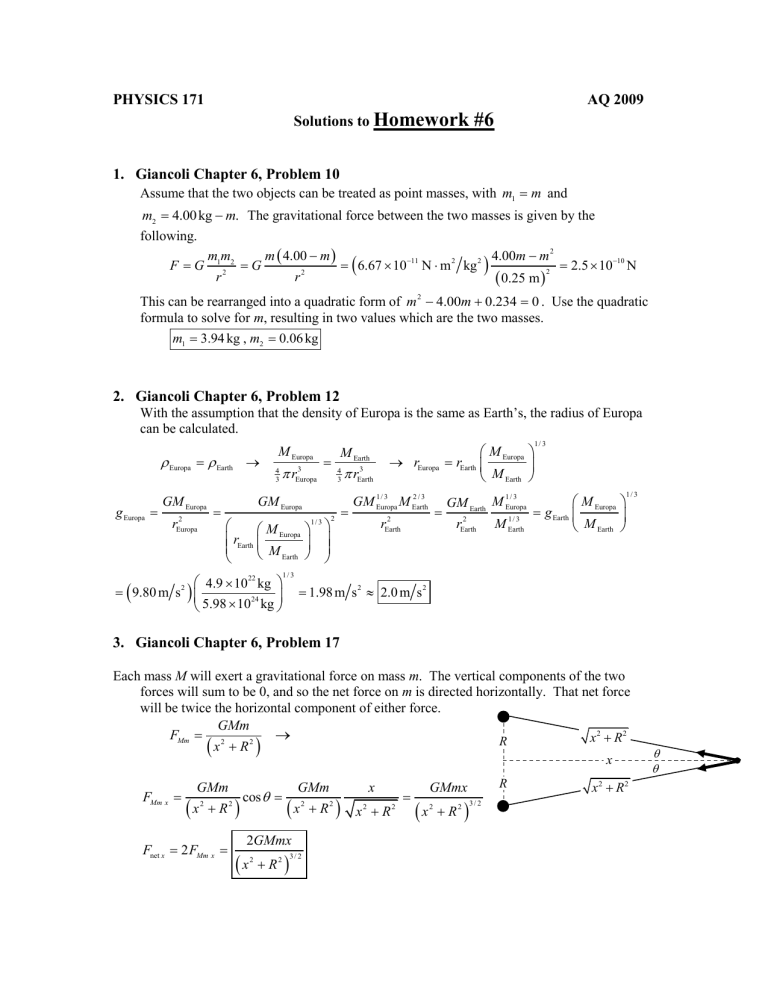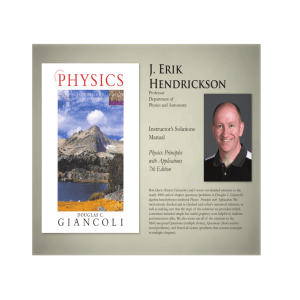Solutions #6
advertisement

PHYSICS 171 AQ 2009 Solutions to Homework #6 1. Giancoli Chapter 6, Problem 10 Assume that the two objects can be treated as point masses, with m1 m and m2 4.00 kg m. The gravitational force between the two masses is given by the following. 2 m 4.00 m mm 11 2 2 4.00m m F G 12 2 G 6.67 10 N m kg 2.5 10 10 N 2 2 r r 0.25 m This can be rearranged into a quadratic form of m 2 4.00m 0.234 0 . Use the quadratic formula to solve for m, resulting in two values which are the two masses. m1 3.94 kg , m2 0.06 kg 2. Giancoli Chapter 6, Problem 12 With the assumption that the density of Europa is the same as Earth’s, the radius of Europa can be calculated. Europa Earth g Europa GM Europa 2 rEuropa M Europa 4 3 3 rEuropa M Earth 4 3 GM Europa 1/ 3 M Europa rEarth M Earth 3 rEarth 2 1/ 3 rEuropa 1/ 3 2/3 GM Europa M Earth 2 rEarth M Europa rEarth M Earth 1/ 3 GM Earth M Europa 2 rEarth 1/ 3 M Earth 1/ 3 M Europa M Earth g Earth 1/ 3 4.9 1022 kg 5.98 1024 kg 9.80 m s 2 1.98 m s 2 2.0 m s 2 3. Giancoli Chapter 6, Problem 17 Each mass M will exert a gravitational force on mass m. The vertical components of the two forces will sum to be 0, and so the net force on m is directed horizontally. That net force will be twice the horizontal component of either force. GMm FMm 2 x 2 R2 R x R2 x FMm x GMm x 2 R2 Fnet x 2 FMm x cos GMm x 2 2GMmx x 2 R2 3/ 2 R2 x x2 R2 R GMmx x 2 R2 3/ 2 x 2 R2 r 4. Giancoli Chapter 6, Problem 20 We can find the actual g by taking g due to the uniform Earth, subtracting away g due to the bubble as if it contained uniform Earth matter, and adding in g due to the oil-filled bubble. In the diagram, r = 1000 m (the diameter of the bubble, and the distance from the surface to the center of the bubble). The mass of matter in the bubble is found by taking the density of the matter times the volume of the bubble. g oil g uniform g bubble g bubble present Earth g g oil (Earth matter) rE r rE (oil) g uniform g bubble g bubble present Earth r2 (Earth matter) GM bubble GM bubble oil (oil) G 3 2 M bubble M bubble 2 oil Earth 43 rbubble r oil r (Earth matter matter) (Earth matter) G r2 The density of oil is given, but we must calculate the density of a uniform Earth. m 5.98 1024 kg Earth 4 E 3 5.50 103 kg m 3 3 6 4 rE 3 6.38 10 m matter 3 g G 3 oil Earth 43 rbubble r matter 2 6.67 10 N m kg 8.0 10 1.00 10 m 11 2 3 2 2 2 kg m3 5.50 103 kg m 3 5.0 10 m 4 3 2 3 1.6414 104 m s2 1.6 104 m s2 Finally we calculate the percentage difference. g 1.6414 104 m s2 100 1.7 103% % g 9.80 m s2 The negative sign means that the value of g would decrease from the uniform Earth value. 5. Giancoli Chapter 6, Problem 30 The speed of an object in an orbit of radius r around the Earth is given in Example 6-6 by v G M Earth r , and is also given by v 2 r T , where T is the period of the object in orbit. Equate the two expressions for the speed and solve for T. Also, for a “near-Earth” orbit, r REarth . G M Earth r T 2 2 r T 2 T r3 GM Earth 6.38 10 m 5070 s 84.5 min N m kg 5.98 10 m 3 6 3 REarth 2 GM Earth 6.67 10 11 2 2 24 No , the result does not depend on the mass of the satellite 6. Giancoli Chapter 6, Problem 38 Knowing the period of the Moon and the distance to the Moon, we can calculate the speed of the Moon by v 2 r T . But the speed can also be calculated for any Earth satellite by v G M Earth r , as derived in Example 6-6. Equate the two expressions for the speed, and solve for the mass of the Earth. G M Earth r 2 r T M Earth 4 2 r 3 GT 2 4 2 3.84 108 m 6.67 10 11 2 N m kg 2 3 27.4 d 86, 400 s d 2 5.98 1024 kg 7. Giancoli Chapter 6, Problem 46 d dN F (a) In a short time t , the planet will travel a v t N distance vt along its orbit. That distance is Sun essentially a straight line segment for a short time duration. The time (and distance moved) during t have been greatly exaggerated on the diagram. Kepler’s second law states that the area swept out by a line from the Sun to the planet during the planet’s motion for the t is the same anywhere on the orbit. Take the areas swept out at the near and far points, as shown on the diagram, and approximate them as triangles (which will be reasonable for short t ). Area N Area F 1 2 vN t d N 12 vF t d F vN vF d F d N (b) Since the orbit is almost circular, an average velocity can be found by assuming a circular orbit with a radius equal to the average distance. vavg 2 r 2 1 2 dN dF 2 1 2 1.47 10 11 m 1.52 1011 m 2.973 10 4 ms T T 3.16 10 s From part (a) we find the ratio of near and far velocities. vN vF d F d N 1.52 1.47 1.034 For this small change in velocities (3.4% increase from smallest to largest), we assume that the minimum velocity is 1.7% lower than the average velocity and the maximum velocity is 1.7% higher than the average velocity. 7 vF t vN vavg 1 0.017 2.973 104 m s 1.017 3.02 10 4 m s vF vavg 1 0.017 2.973 104 m s 0.983 2.92 10 4 m s 8. Giancoli Chapter 7, Problem 16 Use Eq. 7.4 to calculate the dot product. A B Ax Bx Ay By Az Bz 2.0 x 2 11.0 4.0 x 2.5 x 5.0 0 22 x 2 10 x 2 12 x 2 9. Giancoli Chapter 7, Problem 22 Both vectors are in the first quadrant, so to find the angle between them, we can simply subtract the angles of each of them. 2.0 N 2 4.0 N 2 1.0 m 2 5.0 m 2 F 2.0ˆi 4.0ˆj N F d 1.0ˆi 5.0ˆj m d 20 N ; F tan 1 tan 1 2.0 W Fd cos (b) W Fx d x Fy d y 2.0 N 1.0 m 4.0 N 5.0 m 22 J 4.0 2.0 5.0 26 m ; d tan 1 tan 1 5.0 1.0 (a) 20 N 26 m cos tan 1 5.0 tan 1 2.0 22 J 10. Giancoli Chapter 7, Problem 32 To be perpendicular to the given vector means that the dot product will be 0. Let the unknown vector be given as uˆ ux ˆi u y ˆj. uˆ 3.0ˆi 4.0ˆj 3.0u x 4.0u y u y = 0.75u x ; unit length u x2 u 2y 1 ux2 u 2y ux2 0.75ux 1.5625ux2 1 ux 2 1 1.5625 0.8 , u y 0.6 So the two possible vectors are uˆ 0.8ˆi 0.6ˆj and uˆ 0.8ˆi 0.6ˆj . Note that it is very easy to get a non-unit vector perpendicular to another vector in two dimensions, simply by interchanging the coordinates and negating one of them. So a nonunit vector perpendicular to 3.0ˆi 4.0ˆj could be either 4.0ˆi 3.0ˆj or 4.0ˆi 3.0ˆj . Then divide each of those vectors by its magnitude (5.0) to get the possible unit vectors. 11. Giancoli Chapter 7, Problem 54 We assume the train is moving 20 m/s (which is about 45 miles per hour), and that the distance of “a few city blocks” is perhaps a half-mile, which is about 800 meters. First find the kinetic energy of the train, and then find out how much work the web must do to stop the train. Note that the web does negative work, since the force is in the OPPOSITE direction of the displacement. 2 Wto stop K 12 mv22 12 mv12 0 12 104 kg 20 m s 2 106 J train Wweb kx 2 10 J k 1 2 2 6 800 m 2 2 106 J 6N m 2 Note that this is not a very stiff “spring,” but it does stretch a long distance. 12. Giancoli Chapter 7, Problem 62 FT (a) From the free-body diagram for the load being lifted, write Newton’s second law for the vertical direction, with up being positive. F FT mg ma 0.150mg FT 1.150mg 1.150 265 kg 9.80 m s 2 2.99 10 N (b) The net work done on the load is found from the net force. Wnet Fnet d cos 0o 0.150mg d 0.150 265 kg 9.80 m s 2 8.96 103 J (c) The work done by the cable on the load is as follows. Wcable FT d cos 0o 1.150mg d 1.15 265 kg 9.80 m s 2 (d) The work done by gravity on the load is as follows. WG mgd cos180o mgd 265 kg 9.80 m s 2 (e) 23.0 m 23.0 m 6.87 10 J 23.0 m 4 5.97 104 J Use the work-energy theorem to find the final speed, with an initial speed of 0. Wnet K 2 K1 mv mv 1 2 2 2 1 2 2 1 v2 2Wnet m v 2 1 mg 3 2 8.96 103 J 265kg 0 8.22 m s






